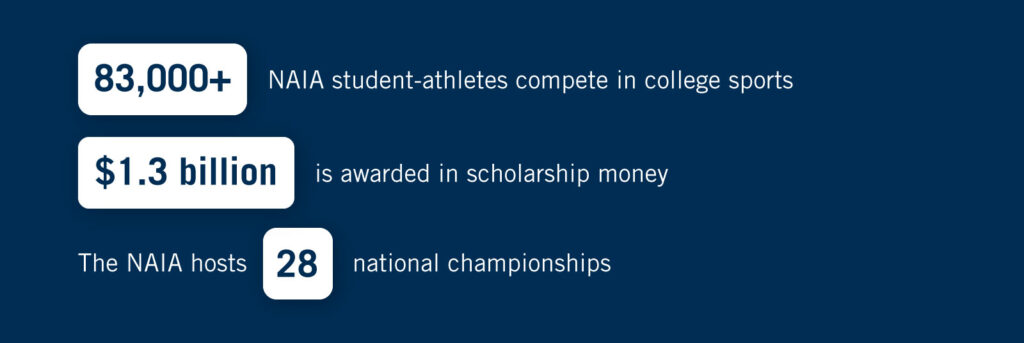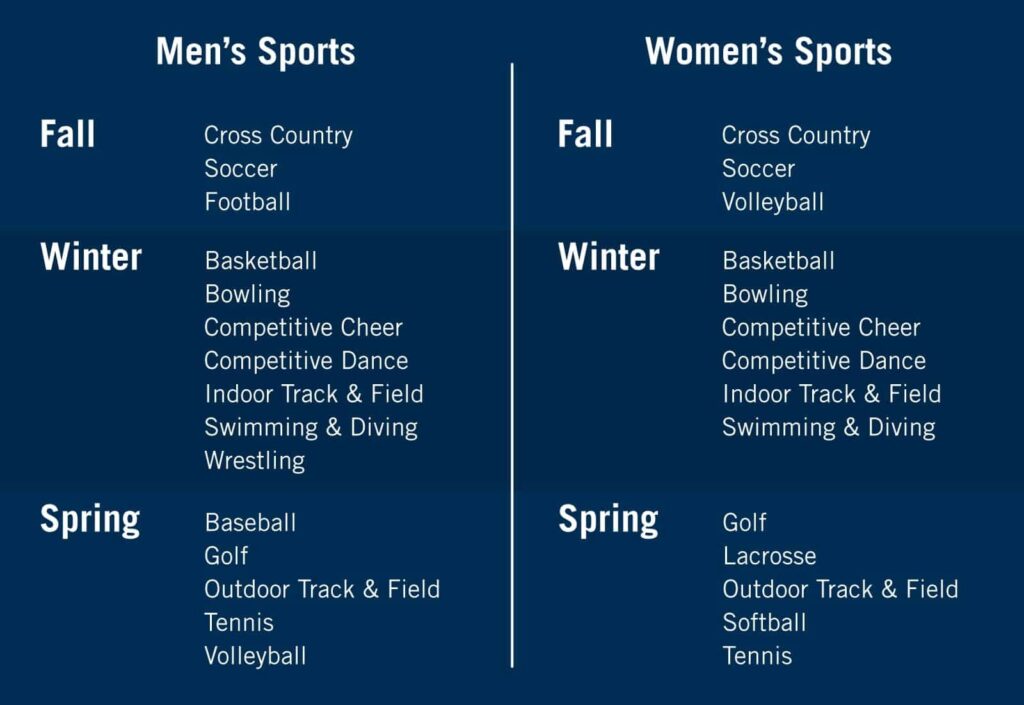If you want to play college sports, you might be wondering what is NAIA? What about NAIA vs NCAA? Which is better for me? Below we’ll go over both the NCAA and NAIA and their differences.
Quick Links
What is NAIA?
NAIA is a college athletics governing body for small college athletics programs. The NAIA offers student-athletes an opportunity to earn athletic scholarships in 28 different sports at more than 250 schools across the country. NAIA stands for National Association of Intercollegiate Athletics.
NAIA Fast Facts

According to the NAIA’s website, each year:
- 83,000+ NAIA student-athletes compete in college sports
- $1.3 billion is awarded in scholarship money
- The NAIA hosts 28 national championships
What is the NCAA?
The National Collegiate Athletic Association (NCAA) is made up of members who serve college athletes. The NCAA is divided into D1, D2, and D3 leagues. According to their website, they participate in 22 athletics conferences and there are 1,115 schools split as follows:
- Division 1 includes 363 schools
- Division 2 includes 314 schools
- Division 3 includes 438 schools
Generally, athletes in D1 schools practice and train the hardest. D2 and D3 school athletes practice less, with D3 athletes practicing and training the least.
Is the NAIA as good as the NCAA?
NAIA programs are comparable to NCAA D3 schools. Top-level NAIA programs match the talent found at mid/high-level NCAA D2 schools. Sometimes athletes will select a top 25 NAIA program over a lower ranked D2 program because the competition level is quite similar.
In the video below, NCSA recruiting experts Kyle Winters and David Kmiecik sit down with former NJCAA, D3 athlete and NJCAA coach, Pat O’Malley, to explain the differences between NAIA vs. NCAA, including some significant advantages NAIA schools can provide for student-athletes.
As the NAIA continues to grow, so does the competition level. NAIA schools are recruiting a larger pool of athletes than they used to, creating a deeper, more talented level of competition.
For athletes who may be just short of reaching NCAA recruiting standards, the NAIA offers a competitive alternative to the NCAA. You can still compete rigorously in the NAIA.
We asked former NAIA athletes why they decided to compete at the NAIA level. Here’s what they said:
Why should I consider an NAIA school?
Recruits whose skillset is comparable to that of NCAA D3 athletes and mid/high-level D2 athletes should consider their options at the NAIA level. While the NCAA may be the better known of the two governing bodies, there are several reasons the NAIA is a great alternative to the NCAA:
More playing time
Competition for a spot on an NCAA Division 1 school roster is extremely high. Even if an athlete secures a roster spot, they still must fight for playing time throughout the season. NAIA programs often offer athletes more opportunity to compete.
More free time
Between training and competing, NCAA Division 1 and Division 2 athletes dedicate 30 hours or more per week to athletics. NAIA programs have fewer practice and competition hours, creating a less stressful environment where you can better balance your academic, social, and athletic schedules.
Also, because the training and practice requirement takes up so much time, many take harder classes during the summer to graduate on time. In the NAIA, you may not need to do that.
Less time traveling
Unlike NCAA programs that often travel across the country for competitions, NAIA programs typically compete against local and regional teams while still being given opportunities to compete for national championships.
No recruiting restrictions
The NAIA does not restrict when and how college coaches can contact recruits. This allows coaches and athletes to communicate throughout their high school careers so you can talk to prospective coaches without worry.
Athletic scholarship opportunities
While NAIA programs typically have smaller recruiting budgets, the NAIA has awarded over $800 million in athletic scholarships. Student-athletes struggling to find scholarship opportunities with an NCAA program may have a better chance of securing financial funding from an NAIA program.
Below is a list of all the men’s and women’s sports offered at NAIA institutions across the three competition seasons. For a list of the top NAIA schools, visit our Power Rankings.
sports offered at NAIA Institutions

We asked former NAIA athletes why current student-athletes should check out NAIA schools and what advice they had to share. Here’s what they said:
High school athletes should check out NAIA schools to find out if these programs fit their specific needs. If they’re looking for an opportunity to balance and succeed at both academics and athletics, then NAIA is a great option. Something often overlooked is the NAIA’s dedication to the “Champions of Character” initiative, which ensures every athletic department offers student-athletes a chance to grow in the core values of the NAIA: integrity, respect, responsibility, and servant leadership.
Renae Littrell, Doane University, Head Softball Coach
It’s every athlete’s goal to be DI. The reality that hit me is: there’s a very small chance to play at that level. You have to look at other factors in recruiting. The NAIA provides an opportunity to earn an athletic scholarship, receive a great education, balance between football and academics, and a very competitive environment for football. My advice to high school athletes would be to not rule anything out until you’ve watched an NAIA game and visited one of their institutions.
Eric Williamson, St. Ambrose University, football
There are a lot of high-level, competitive teams at the NAIA level with a lot of scholarship opportunities. The top NAIA programs obtain DI and DII talent across the country.
Chase Spreen, Lindsey Wilson College, basketball, All-American
Do NAIA schools offer full athletic scholarships?
Yes, the NAIA awards over $1.3 billion in athletic scholarships to student-athletes competing at NAIA institutions each year. Each sport has a maximum number of scholarships they are allowed to award recruits.
NAIA athletic scholarships are equivalency scholarships, meaning coaches can divide up their scholarship budget between multiple athletes.
Similar to most athletic scholarships, NAIA scholarships are not guaranteed year to year and must be renewed at the discretion of the coach/school.
Check out NCSA recruiting experts, Kyle Winters and Pat O’Malley, for more information on the types of scholarships available to student-athletes at the NAIA level.
NAIA scholarships by sport
The numbers below represent the maximum number of scholarships available to an NAIA team by sport.
| NAIA Sports | Scholarships Available Per Team |
|---|---|
| Football | 24 |
| Soccer | 12 |
| Baseball | 12 |
| Track and Field | 12 |
| Lacrosse | 12 |
| Competitive Cheer | 12 |
| Softball | 10 |
| Wrestling | 10 |
| Competitive Dance | 10 |
| Basketball | 8 |
| Volleyball | 8 |
| Swimming & Diving | 8 |
| Men’s Volleyball | 8 |
| Golf | 6 |
| Cross Country | 5 |
| Tennis | 5 |
| Bowling | 5 |
It’s important to note that, like NCAA programs, not every NAIA program is fully funded. This means that it is not guaranteed all programs will have the budget to fund the maximum number of scholarships each team is allotted.
Does NAIA have a signing day?
There is no NAIA signing date or deadline. Recruits also have the flexibility to sign with more than one NAIA offer as they take the time to decide which NAIA college they will actually attend.
Some colleges and universities can have you sign a Letter of Intent, but that doesn’t mean you are required to attend.
NAIA Eligibility Center
If you’re a first-time student-athlete interested in an NAIA program, you must register for the NAIA Eligibility Center at PlayNAIA.org to determine eligibility.
Registering is easy. Athletes will create a personal profile with the basic facts about their academic history and sports participation. To compete in an NAIA program, you must be approved by the NAIA Eligibility Center before competing.
Keep in mind that the NAIA and NCAA are two separate associations, meaning recruits must register for the NCAA and NAIA Eligibility Centers if they have programs from both governing bodies on their list of schools.
To learn more, visit our NAIA Eligibility Requirements page.
Please check out the NAIA transfer rules page if you’re interested in transferring to the NAIA.
NAIA recruiting rules and calendar
Unlike the NCAA, the NAIA does not regulate the contact between a student-athlete and a coach. The NAIA does not have any recruiting rules, calendars, dead periods, contact restrictions, etc.
This means college coaches and student-athletes can more freely communicate, allowing recruits to become more comfortable with the school and athletics staff during the recruiting process.
Also, the NAIA does not limit the number of campuses a student like yourself can visit. You visit as many campuses as possible to determine what programs are the right fit for you.
While NAIA programs are not restricted by recruiting rules and calendars, NAIA coaches tend to recruit athletes later in their high school career, often during their senior year. Why is this?
One recruiting strategy of NAIA coaches is to recruit unsigned talent, so they are known to wait until after National Signing Day. This is when most athletes committing to an NCAA program sign their NLI. If you want to be recruited by an NAIA program, coaches will likely contact you after National Signing Day.
Related Articles
- Visit our NAIA Eligibility hub for more information about everything NAIA.
